IngMar Medical QuickLung Breather User manual

USA Toll Free: 1 (800) 583-9910 | International:+1 (412) 441-8228 | s[email protected]
User’ s Manual QuickLung Breather, Rev. 3, Part No. 80 20 200 © IngMar Medical, LLC. 2021

2
User’s Manual QuickLung Breather, Rev. 3 © IngMar Medical, LLC. 2021
Document History
Revision History
Date
Authors
Rev. 1
6/20/2017
Stefan Frembgen/Michael Bails
Rev. 2
9/24/2018
Samantha Schadwinkel
Rev. 3
2/24/2021
Michael Bails

3
User’ s Manual QuickLung Breather, Rev. 3 © IngMar Medical, LLC. 2021
LEGAL INFORMATION
Product Warranty
Educational tools and test instruments manufactured or distributed by IngMar Medical come
with a limited warranty, covering materials and workmanship, for a period of one year from the
date of shipment, except for products with stated warranties other than one year. Software,
fuses and batteries are excluded from this warranty. System components such as computers
are supplied with the factory warranty of the original manufacturer. IngMar Medical reserves
the right to perform warranty service(s) at its factory, at an authorized repair center, or at the
customer's installation.
IngMar Medical's obligations under this warranty are limited to repairs, or at IngMar Medical's
option, replacement of any defective parts of the purchased equipment, without charge, if said
defects occur during normal service.
Claims for damages during shipment must be filed promptly with the transportation company.
All correspondence concerning the equipment must specify both the model name and number,
and the serial number as it appears on the equipment.
Improper use, mishandling, tampering with, or operation of the equipment without following
specific operating instructions will void this warranty and release IngMar Medical from any
further warranty obligations.
The above is the sole warranty provided by IngMar Medical, LLC. No other warranty, expressed
or implied, is intended. Representatives of IngMar Medical are not authorized to modify the
terms of this warranty.
For factory repair service, call:
Toll free: 1 (800) 583-9910
International: +1 (412) 441-8228
Facsimile: +1 (412) 441-8404
Or contact us via e-mail at: [email protected]
Our shipping address:
IngMar Medical, LLC.
5940 Baum Blvd
Pittsburgh, PA 15206
USA
Please note that a valid service repair order (SRO) no. is always required before sending in any
products for repair, calibrations, or updates.

4
User’s Manual QuickLung Breather, Rev. 3 © IngMar Medical, LLC. 2021
Limitation of Liability
IngMar Medical LLC.'s liability, whether arising out of or related to manufacture and sale of the
goods, their installation, demonstration, sales representation, use, performance, or otherwise,
including any liability based upon above defined product warranty, is subject to and limited to
the exclusive terms and conditions as set forth, whether based upon breach of warranty or any
other cause of action whatsoever, regardless of any fault attributable to IngMar Medical, and
regardless of the form of action (including, without limitation, breach of warranty, negligence,
strict liability, or otherwise).
THE STATED EXPRESSED WARRANTIES ARE IN LIEU OF ALL OTHER WARRANTIES, EXPRESSED OR
IMPLIED, INCLUDING, WITHOUT LIMITATION, WARRANTIES OF MERCHANTABILITY, FITNESS
FOR ANY PARTICULAR PURPOSE, OR NONINFRINGEMENT.
IngMar Medical, LLC. shall not be liable for, nor shall buyer be entitled to recover, any special
incidental or consequential damages or for any liability incurred by buyer to any third party in
any way arising out of or relating to the goods.
Patents
The device is protected under US patent 5975748 which IngMar Medical, LLC. uses under
exclusive license.
Trademarks
QuickLung® is a registered trademark of IngMar Medical, LLC.
Windows®, MS-DOS®, and Excel® are registered trademarks of Microsoft Corporation.
All other trademarks or registered trademarks are property of their respective owners.
Copyright
© 2021, IngMar Medical, LLC.
No parts of this document may be reproduced, stored in a retrieval system, translated,
transcribed, or transmitted, in any form, or by any means, without identifying its authorship as
IngMar Medical, LLC.

5
User’ s Manual QuickLung Breather, Rev. 3 © IngMar Medical, LLC. 2021
Table of Contents
Legal Information.................................................................................................................. 3
1About the User’s Manual............................................................................................. 7
1.1 CONVENTIONS USED IN THIS MANUAL ............................................................................... 7
2Safety Considerations.................................................................................................. 7
2.1 OPERATOR SAFETY........................................................................................................ 7
2.1.1 Intended Use.............................................................................................................................7
2.2 SUMMARY OF GENERAL PRECAUTIONS ............................................................................... 9
3An Introduction to the QuickLung Breather ............................................................... 10
3.1 SYSTEM OVERVIEW ..................................................................................................... 10
3.2 SYSTEM FEATURES AND OPTIONS .................................................................................... 10
⎯Eupnea ® (shallow breathing) .................................................................................... 10
⎯Cheyne-Stokes ® (periodic breathing) ........................................................................ 10
⎯Biot’s ® (groups of quick, shallow inspiration)............................................................ 10
⎯Kussmaul’s ® (deep and labored breathing) ............................................................... 10
⎯Apneusis ® (deep, gasping inspiration with a pause) at full inspiration ....................... 10
4ASL QuickLung Breather Setup................................................................................... 11
4.1 INSTALLING THE QUICKLUNG ......................................................................................... 11
4.2 ELECTRICAL CONNECTIONS ............................................................................................ 12
5Running a Simulation ................................................................................................ 13
6Using Different Modes of Spontaneous Breathing...................................................... 16
6.1 EUPNEA ................................................................................................................... 17
6.2 CHEYNE-STOKES ......................................................................................................... 17
6.3 BIOT’S..................................................................................................................... 18
6.4 KUSSMAUL’S............................................................................................................. 18
6.5 APNEUSIS ................................................................................................................. 18
6.6 USING THE APNEA FEATURE .......................................................................................... 19
7Support..................................................................................................................... 20
7.1 SUPPORT RESOURCES .................................................................................................. 20
7.2 FREQUENTLY ASKED QUESTIONS (FAQS) .......................................................................... 20
7.3 TROUBLESHOOTING ..................................................................................................... 21
8Maintenance............................................................................................................. 22
9Technical Data........................................................................................................... 23
9.1 PERFORMANCE SPECIFICATIONS ...................................................................................... 23
9.2 ELECTRICAL SPECIFICATIONS........................................................................................... 23

6
User’s Manual QuickLung Breather, Rev. 3 © IngMar Medical, LLC. 2021
9.3 PHYSICAL SPECIFICATIONS ............................................................................................. 24
9.4 ENVIRONMENTAL SPECIFICATIONS ................................................................................... 24
10 Index......................................................................................................................... 25
11 List of Figures............................................................................................................ 26

7
1ABOUT THE USER’S MANUAL
This User’s Manual is for IngMar Medical’s QuickLung Breather, the Spontaneous Breathing Accessory
for the QuickLung Precision Test Lung. It is recommended that you read this instruction manual
carefully before using the QuickLung Breather.
This manual is divided into several main sections to help you easily access information and instructions
you need.
1.1 Conventions Used in This Manual
WARNING!
Indicates a potentially harmful condition that can lead to personal injury.
CAUTION!
Indicates a condition that may lead to equipment damage or malfunction
NOTE
Indicates points of particular interest or emphasis for more efficient or convenient operation.
Use of the word “Patient”
Throughout this manual and in the software, the word “patient“ is used to describe a simulated patient
with specific lung model settings. This reference corresponds to the use of “patient” in a clinical setting
who receives ventilator assistance.
2SAFETY CONSIDERATIONS
2.1 Operator Safety
For correct and effective use of the product it is mandatory to read and to observe all instructions,
WARNINGS, and CAUTION statements in this manual and on the product. If the product is not used as
instructed, the safety protection provided may be impaired.
2.1.1 Intended Use
The QuickLung Breather is the spontaneous breathing option for the IngMar Medical QuickLung. It
may be used in ventilator management training where the need for a spontaneously breathing
respiratory simulator is essential while addressing topics of synchrony, patient support, and weaning.

8
User’s Manual QuickLung Breather, Rev. 3 © IngMar Medical, LLC. 2021
The QuickLung Breather may also be used effectively in ventilator performance verification procedures
that require reproducible breath triggers.
IngMar Medical, LLC. does not recommend any specific ventilator test or calibration procedures
and no portion of these instructions shall be construed as doing so.
Always follow ventilator manufacturers’instructions and recommendations regarding
performance verification procedures.
CAUTION!
Do not allow aerosols to contaminate the bellows of the QuickLung. Contamination with
aerosols may, over time, result in material degradation.
WARNING!
Use of the QuickLung Breather in the presence of flammable anesthetics may present an
explosion hazard.
WARNING!
Electromagnetic Interference: Do not use the QuickLung Breather in patient rooms or other
areas where life supporting equipment is in use.

9
User’ s Manual QuickLung Breather, Rev.3 © IngMar Medical, LLC. 2021
2.2 Summary of General Precautions
CAUTION!
Electrical Supply: Connect the power supply provided only to a properly grounded wall outlet
providing 100 –240 V AC, 50 –60 Hz.
CAUTION!
Do not operate QuickLung Breather when it is wet due to spills or condensation. Never sterilize
or immerse the device in liquids.
CAUTION!
Always use dry air or oxygen with the QuickLung. “Rainout” inside the bellows of the QuickLung
may impair its function and may eventually cause damage.
CAUTION!
Do not operate the QuickLung Breather if it appears to have been dropped or damaged.
WARNING!
Fire Hazards related to the use of oxygen:
When using the system with elevated concentrations of oxygen (ventilators set to
FiO2 > 21%), observe all precautions applicable to the use of oxygen indoors.
•Always use extreme caution when using oxygen!
•Oxygen intensely supports any burning!
No smoking, no open fire in areas where oxygen is in use!
•Always provide adequate ventilation in order to maintain ambient O2 concentrations < 24 %.
•Always secure O2 cylinders against tipping, do not expose to extreme heat.
•Do not use oil or grease on O2 equipment such as tank valves or pressure regulators.
Do not touch with oily hands. Risk of fire!
•Open and close valves slowly, with smooth turns. Do not use any tools.

10
User’s Manual QuickLung Breather, Rev. 3 © IngMar Medical, LLC. 2021
3AN INTRODUCTION TO THE QUICKLUNG BREATHER
3.1 System Overview
The QuickLung Breather acts as a physical “cradle” for the QuickLung (standard or pediatric version
“QuickLung Junior”) mounted on top of it.
Figure 3-1: QuickLung Breather with Accessories
3.2 System Features and Options
The QuickLung Breather offers features and options for the basic as well as the advanced user.
Standard features of the QuickLung Breather include:
•The ability to breathe spontaneously, making a small or large contribution to overall minute
ventilation
•Predefined breathing patterns include:
⎯Eupnea ® (shallow breathing)
⎯Cheyne-Stokes ® (periodic breathing)
⎯Biot’s ® (groups of quick, shallow inspiration)
⎯Kussmaul’s ® (deep and labored breathing)
⎯Apneusis ® (deep, gasping inspiration with a pause) at full inspiration
•Apnea - the ability to breathe intermittently, with a preset or randomized ratio of breath to no-
breath periods
•The ability to vary breath rate and tidal volume randomly with a mean target of minute ventilation

11
User’ s Manual QuickLung Breather, Rev.3 © IngMar Medical, LLC. 2021
Please see 6 Using Different Modes of Spontaneous Breathing for further details on the individual
modes of spontaneous breathing and the adjustable parameters for each of the different patterns.
4ASL QUICKLUNG BREATHER SETUP
4.1 Installing the QuickLung
Before attempting to install the QuickLung, ensure that the lift arms on the side of the QuickLung
breather are in a downward position.
CAUTION!
Make sure that the downward position of the lift arms is not beyond the marking indicated on
the side of the QuickLung Breather chassis.
NOTE
If you already own a QuickLung that does not have the side rails or the “wing” panel installed,
please contact IngMar Medical to obtain the correct part.
On the rear of the Breather, there is a spring-loaded pin used to secure the QuickLung test lung into
place.
•Pull and twist the spring-loaded pin so that the QuickLung can be installed.
•Set the QuickLung onto the Breather by sliding the front of the lung under the Breather locking
brackets and lowering onto the Breather surface.
•Release the spring-loaded pin to secure the lung.
Figure 4-1: QuickLung Locking Pin in the Released and Locked Positions

12
User’s Manual QuickLung Breather, Rev. 3 © IngMar Medical, LLC. 2021
4.2 Electrical Connections
The first step for getting started is to establish safe and proper electrical connections following the
instructions in this section.
•Connect the DC power output cord of the power supply to the DC input jack in the back of the
QuickLung Breather.
•Connect the QuickLung Breather power adapter to line power supplying 100 - 240 V AC, 50/60 Hz
with the power cord for your specific country supplied in the package.
CAUTION!
Electrical Supply: Connect only to a properly grounded wall outlet providing
100 - 240 V AC, 50 - 60 Hz.
1. Plug DC barrel connector into its socket on the back panel of the QuickLung Breather.
Figure 4-2: Electrical Connections
1

13
User’ s Manual QuickLung Breather, Rev.3 © IngMar Medical, LLC. 2021
5RUNNING A SIMULATION
NOTE
When using the QuickLung Breather with a ventilator, please make sure the QuickLung Breather
is configured and running prior to attaching the ventilator circuit.
After safely making the electrical connections and installing the QuickLung, you are now ready to run
your first simulation.
To begin, turn on the system:
1. Flip the power switch at the back of the QuickLung Breather to the ON ( |)position.
Figure 5-1: Turning On the Device
On the front panel, the LCD display will light up and show the QuickLung Settings window.
Figure 5-2: QuickLung Settings Menu
2. Using the left <+/-> buttons on the front panel, set the QL Model to Adult or Junior, matching the
actual QuickLung that is installed on the QuickLung Breather.
2
4
3
1

14
User’s Manual QuickLung Breather, Rev. 3 © IngMar Medical, LLC. 2021
3. Using the right <+/-> buttons to set the Apnea mode to Enabled or Disabled.
4. When complete, press Mode Select to continue.
The last setup window appears, where Resistance and Compliance can be set. Also, the baseline
Offset value is set to provide more accurate tidal volume.
Figure 5-3: Offset and R/C Settings Menu
It is important that the values entered for Res. (Resistance) and Compl. (Compliance) match the
settings of the QuickLung as it is installed. The values are needed to correctly limit spontaneous
breathing settings in the different modes.
CAUTION!
If the QuickLung Breather is set to take excessive breaths (considering the compliance and/or
resistance present), the motor drive will slip and could potentially be damaged.
1. Use the left <+/-> to match Res. to the resistance setting of the QuickLung.
2. Use the right <+/-> to match Compl. to the compliance setting of the QuickLung.
NOTE on Offset:
For correct estimates of the spontaneously inhaled volume, Offset should be adjusted so
that, at rest, the lift arms are just touching the “wing” (bracket) from below. This is
necessary as the characteristics that make up the QuickLung rubber bellow are not
exact. The offset allows the user to create a “zero” position of the lift-arms such that
increased accuracy is attained when dialing in a tidal volume.
3. Use the center <-> to set the Offset value to zero (0),
3
1
2
4
5

15
User’ s Manual QuickLung Breather, Rev.3 © IngMar Medical, LLC. 2021
4. Press Start/Stop. This places the lift-arms at the “absolute” zero position.
5. Use center <+> to increase the Offset value, and then press Start/Stop again to verify position of
the lift-arms. Repeat as necessary until the lift-arms are just touching the QuickLung wing.
Figure 5-4: Offset Not Adjusted (Left) and Properly Adjusted (Right)
6. When complete, press Mode Select to cycle through and select one of the pre-defined breath
patterns. Use the <+/-> to adjust the settings of each pattern.
7. Press Start/Stop to start a simulation with the preselected mode and settings of that mode.
8. The symbol ■ then turns into ►,to indicate the system is running.
Figure 5-5: Eupnea Breathing Pattern Settings
NOTE
All settings for a particular breath pattern are retained when you switch to a different mode
and will be effective again when the original mode is chosen.
The basic patterns available are depicted in the Figure below. For details on using the different modes
of breathing patterns, please see the next section of this manual.
7
8
6

16
User’s Manual QuickLung Breather, Rev. 3 © IngMar Medical, LLC. 2021
Figure 5-6: Eupnea Breathing Pattern Settings
NOTE
Pictures of all breath pattern are examples and doesn’t change with selected values or time.
6USING DIFFERENT MODES OF SPONTANEOUS BREATHING
The following section describes the different breathing patterns available in the QuickLung Breather,
together with the respective ranges of breath rate, inhalation time (Ti), flow rate, and the maximum
spontaneous tidal volume possible. The values in brackets represent default values for each breath
pattern.
NOTE
The inhalation time (Ti) describes the inspiratory time over the total cycle time represented as a
percentage.
NOTE
Vt indicated in this context is representative only for applications where no PEEP is present that
would require the Offset to be adjusted, diminishing the maximum available tidal volume. Max
Vt settings are indented to protect the internal mechanism and may vary slightly due to
QuickLung bellow characteristics.
Generally, high Resistance settings and small Compliance settings limit the range of flow and volume.
R = 5 cmH2O
R = 20 cmH2O
R = 50 cmH2O
C = 50 mL/cmH2O
C = 20 mL/cmH2O
C = 10 mL/cmH2O
Max. Flow
80 L/min
40 L/min
20 L/min
Max. Vt
720 mL
500 mL
250 mL
•Eupnea
•Cheyne-Stokes
•Biot’s
•Kussmaul’s
•Apneusis

17
User’ s Manual QuickLung Breather, Rev.3 © IngMar Medical, LLC. 2021
For the QuickLung Junior, the respective values are:
R = 5 cmH2O
R = 20 cmH2O
R = 50 cmH2O
C = 15 mL/cmH2O
C = 6 mL/cmH2O
C = 3 mL/cmH2O
Max. Flow
80 L/min
40 L/min
20 L/min
Max. Vt
360 mL
250 mL
100 mL
6.1 Eupnea
Eupnea is the mode setting with which to simulate “normal” breathing. Wikipedia defines Eupnea as
“normal, good, unlabored breathing, sometimes known as quiet breathing or resting respiratory rate.
In eupnea, expiration employs only the elastic recoil of the lungs.”[
1
]
The range of parameters that are available is depicted in the table below:
Rate [BPM]
Volume [mL]
Ti [%]
MV [L]
Insp. Hold [%]
QuickLung
4…60 (12[2])
80…720 (300)
20…80 (50)
QL Junior
4…60 (12)
40…360 (150)
20…80 (50)
Eupnea mode is very flexible and can be considered a default and starting point for many simulation
applications.
6.2 Cheyne-Stokes
Cheyne-Stokes respiration “is an abnormal pattern of breathing characterized by progressively deeper,
and sometimes faster, breathing followed by a gradual decrease that results in a temporary stop in
breathing called an apnea. The pattern repeats, with each cycle usually taking 30 seconds to 2 minutes.
It is an oscillation of ventilation between apnea and hyperpnea with a crescendo-diminuendo
pattern”.[
3
]
The range of parameters that are available is depicted in the table below:
Rate [BPM]
Volume [mL]
Ti [%]
MV [L]
Insp. Hold [%]
QuickLung
4…40 (12)
200…720*
(720)
Fixed (50)
QL Junior
4…40 (12)
100…360*
(360)
Fixed (50)
* Vmax in a group of breaths
1
Wikipedia.org. Accessed 8 August, 2018.
2
Default values in parentheses
3
Wikipedia.org. Accessed 8 August, 2018.

18
User’s Manual QuickLung Breather, Rev. 3 © IngMar Medical, LLC. 2021
6.3 Biot’s
“Biot's respiration is an abnormal pattern of breathing characterized by groups of quick, shallow
inspirations followed by regular or irregular periods of apnea.” [
4
]
The range of parameters that are available is depicted in the table below:
Rate [BPM]
Volume [mL]
Ti [%]
MV [L]
Insp. Hold [%]
QuickLung
12…60* (18)
80…720 (600)
1.0…9.9 (6.0)
QL Junior
12…60* (18)
40…360 (300)
0.5…4.9 (3.0)
* fmax
6.4 Kussmaul’s
“Kussmaul breathing is a deep and labored breathing pattern often associated with severe metabolic
acidosis, particularly diabetic ketoacidosis (DKA) but also kidney failure. It is a form of hyperventilation,
which is any breathing pattern that reduces carbon dioxide in the blood due to increased rate or depth
of respiration.” [4]
The range of parameters that are available is depicted in the table below:
Rate [BPM]
Volume [mL]
Ti [%]
MV [L]
Insp. Hold [%]
QuickLung
18…60 (18)
200…720 (720)
40…60 (50)
QL Junior
18…60 (30)
60…216 (216)
40…60 (50)
6.5 Apneusis
“Apneustic respiration (a.k.a. apneusis) is an abnormal pattern of breathing characterized by deep,
gasping inspiration with a pause at full inspiration followed by a brief, insufficient release.” [5]
The range of parameters that are available is depicted in the table below:
Rate [BPM]
Volume [mL]
Ti [%]
MV [L]
Insp. Hold [%]
QuickLung
4…40 (12)
80…720 (450)
60…75*
20…50 (25)
QL Junior
4…40 (20)
24…216 (150)
60…75*
20…50 (25)
* set by algorithm
4
, 4, 5 Wikipedia.org. Accessed 8 August, 2018.

19
User’ s Manual QuickLung Breather, Rev.3 © IngMar Medical, LLC. 2021
6.6 Using the Apnea Feature
You can control how apnea enters into the breathing patterns of your simulated patient by selecting
the number of breaths taken (Breaths) and omitted (NoBr). Additionally, you can enter quasi-
randomization into the pattern for more realism. Randomization takes the values of Breaths and NoBr
as median values and allows the actual number of breaths taken and omitted over time to vary in the
range of +/-30%. A seed value for the random number generator starts the pattern. The quasi-random
apnea pattern can thus be repeated based on the set Seed value. Numbers between 1 and 999 are
allowed. Setting the Seed value to zero (0) forces the QuickLung Breather to use the set Breaths and
NoBr as fixed values, without any random fluctuations.
If Apnea is enabled at startup in the QuickLung Settings window, the Apnea Settings window will
appear when Mode is pressed.
Figure 6-1: QuickLung Settings Menu
1. Set the (median) value of the number of breaths that you want your patient to take before an
apnea occurs.
2. Set the (median) value of the number of breaths for which you want your patient to make no effort
(duration of the apnea).
3. Adjust the Seed value to either 0 (no randomization) or a different number for randomization.
4. When complete, press Mode Select button to continue.
5. When Apnea is active in any of the breath patterns, it is indicated by the letter Ain the top right
corner of the display.
1
4
3
2

20
User’s Manual QuickLung Breather, Rev. 3 © IngMar Medical, LLC. 2021
Figure 6-2: Eupnea Breathing Pattern with Apnea
7SUPPORT
7.1 Support Resources
Recognizing that the QuickLung Breather has users from a large number of specialties, IngMar Medical
is dedicated to support its users in many different ways.
We encourage you to visit our website at www.ingmarmed.com as the entry point for up-to-date
information on support options. While the primary source of user information is this User’s Manual,
there are a number of other resources for additional support.
Updated editions of this User’s Manual can be downloaded from the IngMar Medical website.
7.2 Frequently Asked Questions (FAQs)
For questions directly related to the QuickLung Breather, go to:
http://www.ingmarmed.com/products/breather-option-for-the-quicklung-test-lung/
5
Table of contents
Other IngMar Medical Medical Equipment manuals
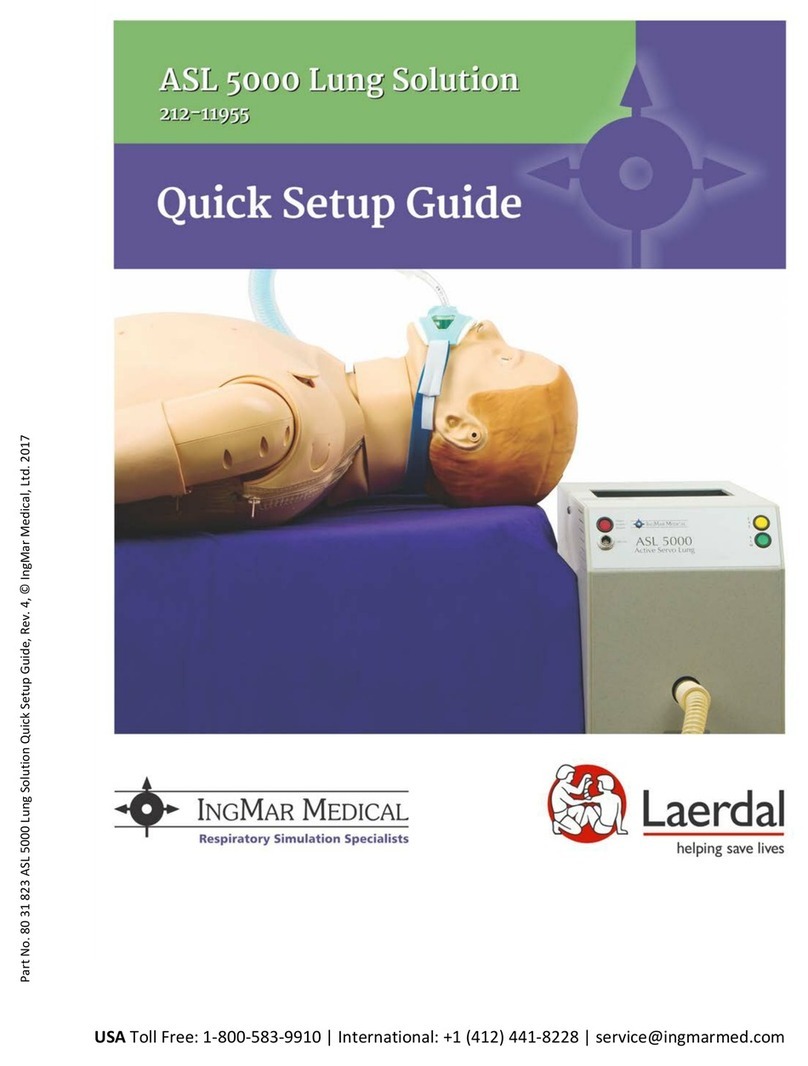
IngMar Medical
IngMar Medical ASL 5000 User manual
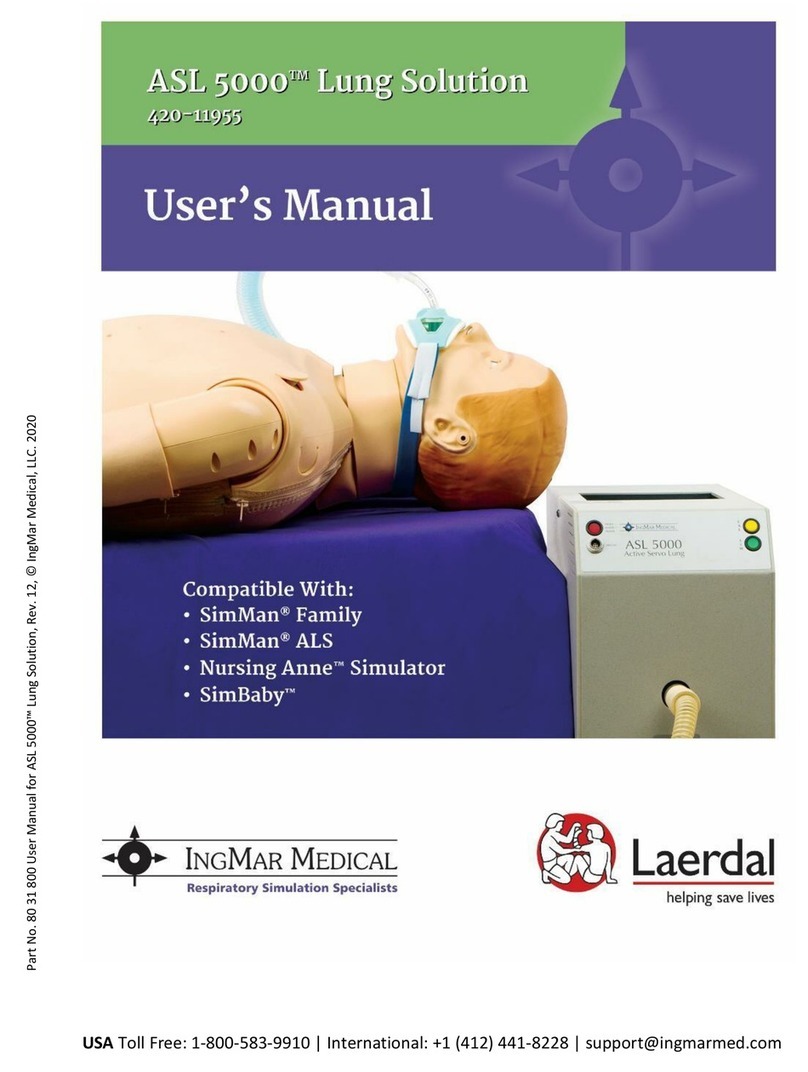
IngMar Medical
IngMar Medical ASL 5000 Lung Solution User manual
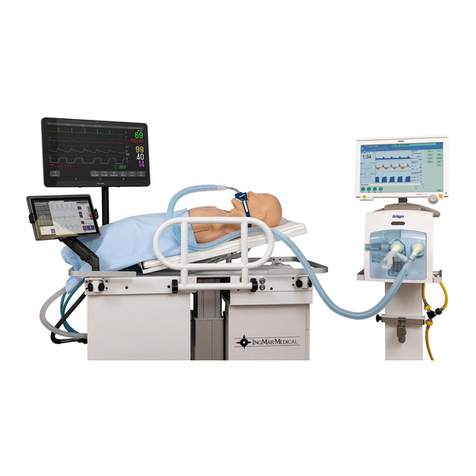
IngMar Medical
IngMar Medical RespiPro User manual

IngMar Medical
IngMar Medical ASL 5000 User manual
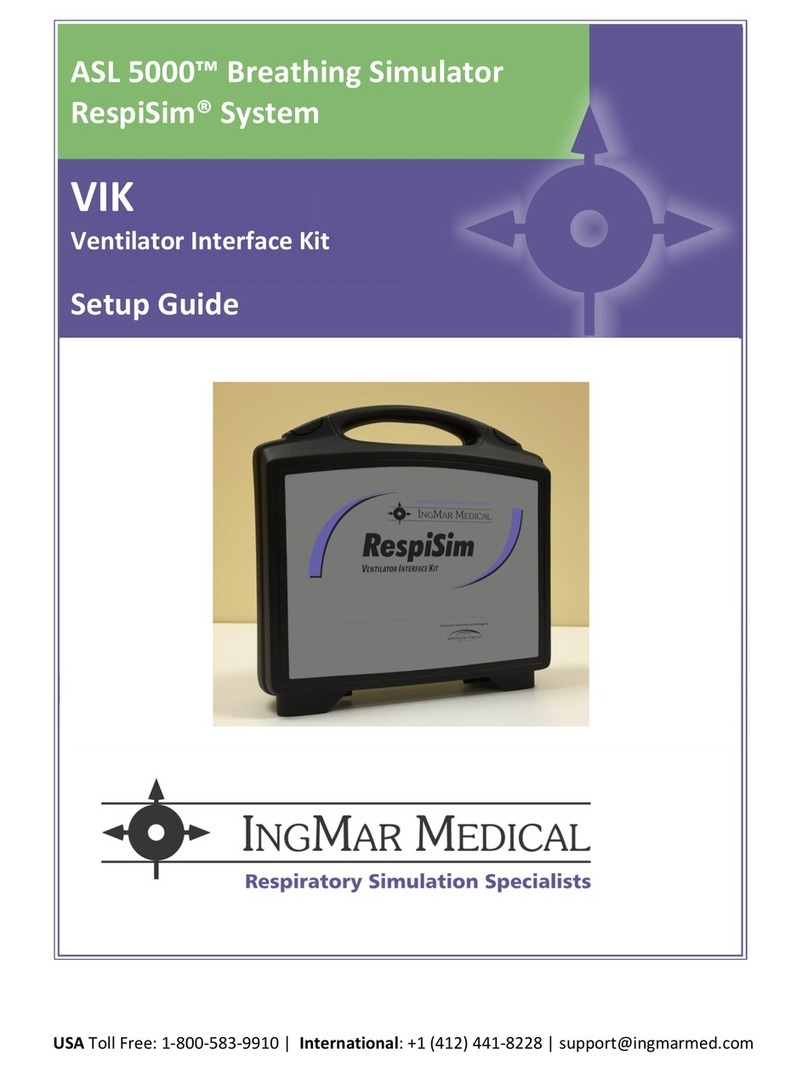
IngMar Medical
IngMar Medical ASL 5000 RespiSim User manual
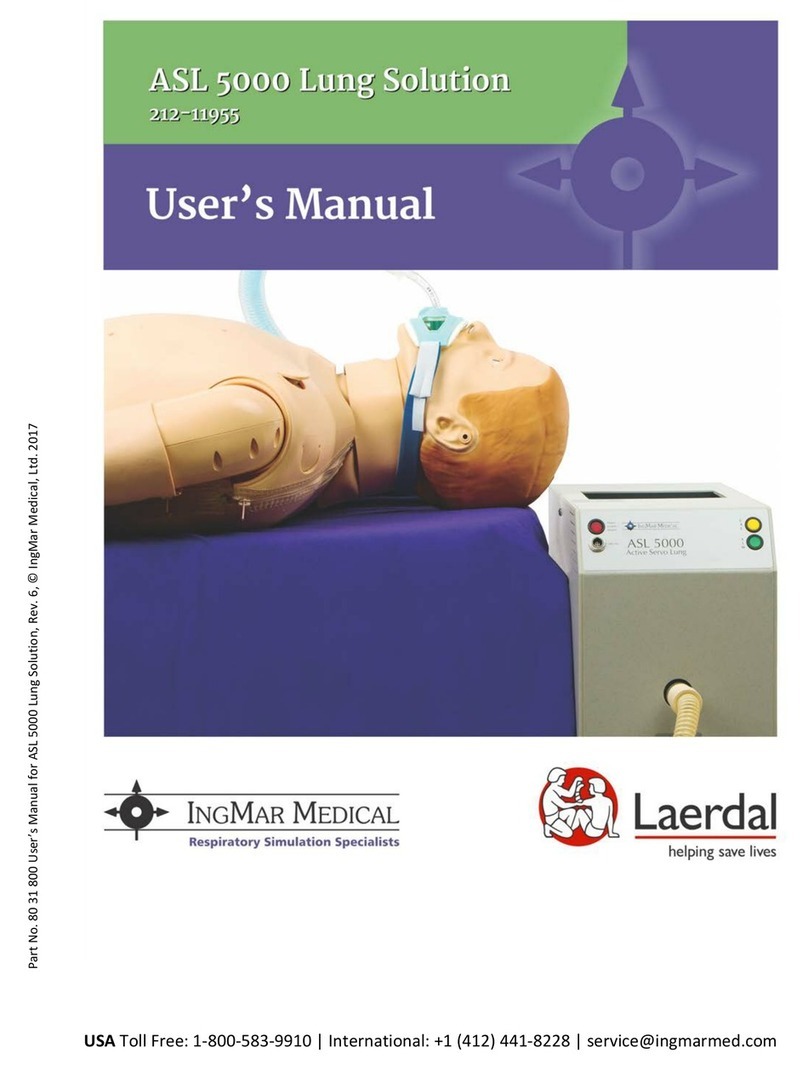
IngMar Medical
IngMar Medical 212-11955 User manual
Popular Medical Equipment manuals by other brands

Getinge
Getinge Arjohuntleigh Nimbus 3 Professional Instructions for use

Mettler Electronics
Mettler Electronics Sonicator 730 Maintenance manual

Pressalit Care
Pressalit Care R1100 Mounting instruction

Denas MS
Denas MS DENAS-T operating manual

bort medical
bort medical ActiveColor quick guide

AccuVein
AccuVein AV400 user manual











